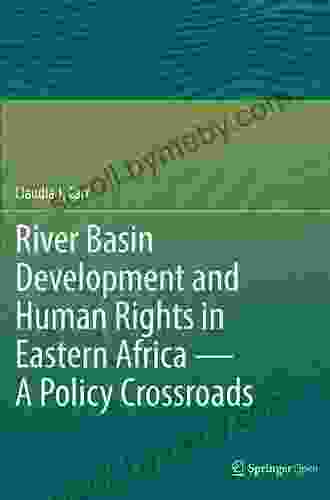River Basin Development and Human Rights in Eastern Africa: A Policy Crossroads

Water is life. It is essential for human survival, health, and well-being. However, access to water is not always equitable, and this can have a devastating impact on human rights. In Eastern Africa, where water resources are scarce, the development of river basins has often led to conflicts over water rights and the displacement of indigenous communities.
This article explores the complex relationship between river basin development and human rights in Eastern Africa. It examines the history of river basin development in the region, the challenges that have been faced, and the lessons that can be learned for future development projects.
5 out of 5
| Language | : | English |
| File size | : | 47377 KB |
| Text-to-Speech | : | Enabled |
| Screen Reader | : | Supported |
| Enhanced typesetting | : | Enabled |
| Word Wise | : | Enabled |
| Print length | : | 479 pages |
History of River Basin Development in Eastern Africa
The development of river basins in Eastern Africa has a long history. The first major river basin development project in the region was the construction of the Aswan High Dam in Egypt in the 1960s. The dam was built to control flooding and provide irrigation water for agriculture. However, the dam also had a number of negative impacts, including the displacement of thousands of Nubian people and the loss of valuable wetlands.
In the 1970s and 1980s, a number of other large-scale river basin development projects were undertaken in Eastern Africa. These projects included the construction of dams, irrigation canals, and hydroelectric power plants. These projects were often justified on the grounds that they would provide economic benefits, such as increased agricultural production and electricity generation. However, these projects also had a number of negative impacts, including the displacement of indigenous communities, the loss of biodiversity, and the disruption of traditional livelihoods.
Challenges of River Basin Development in Eastern Africa
The development of river basins in Eastern Africa has faced a number of challenges, including:
* Water scarcity: Eastern Africa is a water-scarce region, and the demand for water is growing rapidly. This makes it difficult to balance the needs of different water users, such as agriculture, industry, and domestic use. * Climate change: Climate change is expected to exacerbate water scarcity in Eastern Africa. This is because climate change is likely to lead to increased droughts and floods, which will make it more difficult to manage water resources. * Political instability: Eastern Africa is a region of political instability, and this can make it difficult to implement river basin development projects. Conflicts over water rights can also lead to violence and displacement. * Lack of capacity: Eastern African countries often lack the capacity to plan and implement river basin development projects. This can lead to projects that are poorly designed and implemented, which can have negative impacts on human rights and the environment.
Lessons Learned from River Basin Development in Eastern Africa
The development of river basins in Eastern Africa has taught us a number of lessons, including:
* The importance of stakeholder engagement: It is essential to engage with all stakeholders in the planning and implementation of river basin development projects. This includes indigenous communities, local communities, and government agencies. By engaging with stakeholders, we can identify and address their concerns and ensure that their rights are protected. * The need for integrated planning: River basin development projects should be planned and implemented in an integrated manner. This means taking into account the needs of all water users, as well as the environmental and social impacts of the project. * The importance of capacity building: Eastern African countries need to invest in capacity building to ensure that they have the capacity to plan and implement river basin development projects. This includes training in water resources management, environmental impact assessment, and social impact assessment. * The need for adaptive management: River basin development projects need to be adaptive to changing circumstances. This means being able to respond to changes in water availability, climate change, and other factors.
Policy Crossroads
Eastern Africa is at a policy crossroads with regard to river basin development. The region needs to develop policies that promote sustainable and equitable river basin development. These policies should be based on the lessons that have been learned from past projects and should take into account the challenges that the region faces.
Some of the key policy issues that need to be addressed include:
* Water rights: Eastern African countries need to develop clear and equitable water rights frameworks. These frameworks should ensure that all water users have access to the water they need, while also protecting the environment. * Environmental protection: River basin development projects should be designed and implemented in a way that minimizes environmental impacts. This includes protecting wetlands, forests, and other ecosystems that provide important services to humans and the environment. * Social impact assessment: River basin development projects should be subject to social impact assessments to identify and mitigate potential negative impacts on indigenous communities and other vulnerable groups. * Adaptive management: River basin development projects should be adaptive to changing circumstances. This means being able to respond to changes in water availability, climate change, and other factors.
River basin development is a complex undertaking that can have a significant impact on human rights and the environment. In Eastern Africa, where water resources are scarce, the development of river basins has often led to conflicts over water rights and the displacement of indigenous communities.
However, it is possible to develop river basins in a way that promotes sustainable and equitable development. By taking into account the lessons that have been learned from past projects and by addressing the key policy issues, Eastern African countries can develop policies that promote sustainable river basin development and protect human rights.
5 out of 5
| Language | : | English |
| File size | : | 47377 KB |
| Text-to-Speech | : | Enabled |
| Screen Reader | : | Supported |
| Enhanced typesetting | : | Enabled |
| Word Wise | : | Enabled |
| Print length | : | 479 pages |
Do you want to contribute by writing guest posts on this blog?
Please contact us and send us a resume of previous articles that you have written.
 Book
Book Novel
Novel Page
Page Chapter
Chapter Text
Text Story
Story Genre
Genre Reader
Reader Library
Library Paperback
Paperback E-book
E-book Magazine
Magazine Newspaper
Newspaper Paragraph
Paragraph Sentence
Sentence Bookmark
Bookmark Shelf
Shelf Glossary
Glossary Bibliography
Bibliography Foreword
Foreword Preface
Preface Synopsis
Synopsis Annotation
Annotation Footnote
Footnote Manuscript
Manuscript Scroll
Scroll Codex
Codex Tome
Tome Bestseller
Bestseller Classics
Classics Library card
Library card Narrative
Narrative Biography
Biography Autobiography
Autobiography Memoir
Memoir Reference
Reference Encyclopedia
Encyclopedia David Engel
David Engel Clint Coons
Clint Coons Jim Butcher
Jim Butcher Craig Dilouie
Craig Dilouie Elizabeth Earnshaw
Elizabeth Earnshaw Clemantine Wamariya
Clemantine Wamariya Craig Carlson
Craig Carlson Clea Shearer
Clea Shearer Roy Macgregor
Roy Macgregor Cyndi Brannen
Cyndi Brannen Reviel Netz
Reviel Netz D Ward Cornell
D Ward Cornell Cresson H Kearny
Cresson H Kearny Cynthia Chen Mcternan
Cynthia Chen Mcternan John Broome
John Broome Michael Gibney
Michael Gibney Courtney Epps
Courtney Epps Clinnesha D Sibley
Clinnesha D Sibley Colleen Graves
Colleen Graves Kevin Houston
Kevin Houston
Light bulbAdvertise smarter! Our strategic ad space ensures maximum exposure. Reserve your spot today!

 Leslie CarterThe Adventures of a Guilty Liberal Who Attempts to Save the Planet and the...
Leslie CarterThe Adventures of a Guilty Liberal Who Attempts to Save the Planet and the... Liam WardFollow ·3k
Liam WardFollow ·3k Mason PowellFollow ·4.4k
Mason PowellFollow ·4.4k George BellFollow ·5k
George BellFollow ·5k Stan WardFollow ·6.2k
Stan WardFollow ·6.2k Andy ColeFollow ·14.9k
Andy ColeFollow ·14.9k Douglas PowellFollow ·8.2k
Douglas PowellFollow ·8.2k Michael ChabonFollow ·12.2k
Michael ChabonFollow ·12.2k Caleb LongFollow ·3.8k
Caleb LongFollow ·3.8k

 Cruz Simmons
Cruz SimmonsUnveiling the Secrets: An Insider Guide to School Bonds...
Unlock the Power of School...

 Gil Turner
Gil TurnerRuins of Empire: Blood on the Stars - The Epic Space...
Ruins of Empire: Blood on the Stars is the...

 Allen Ginsberg
Allen GinsbergPrepare for the Ultimate Space Opera: Delve into The Last...
Embark on an...

 Anton Foster
Anton FosterUnleash Your Inner Artist: The Ultimate Guide to Oil...
Chapter 1: The...
5 out of 5
| Language | : | English |
| File size | : | 47377 KB |
| Text-to-Speech | : | Enabled |
| Screen Reader | : | Supported |
| Enhanced typesetting | : | Enabled |
| Word Wise | : | Enabled |
| Print length | : | 479 pages |













